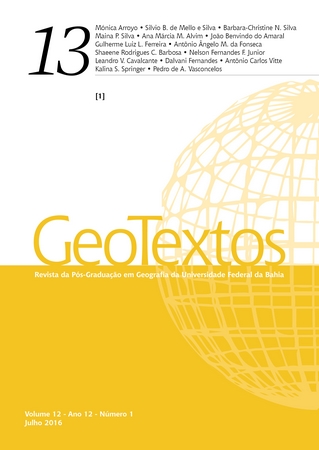INTERMUNICIPAL MIGRATORY MOVEMENTS IN THE STATE OF TOCANTINS (BRAZIL) BETWEEN 1991 AND 2010
DOI:
https://doi.org/10.9771/1984-5537geo.v13i1.20527Keywords:
Migratory Movements, Redistribution of population, ImmigrantsAbstract
The state of Tocantins currently consists of 139 municipalities that differ in demographic size, which varies according to natural growth and migration. Process leading to the redistribution of population over the territory. Therefore, the objective is to analyze the inter-municipal migratory movements that took place in Tocantins between 1991 and 2010. The migration data were obtained from the Brazilian Instituto Brasileiro from Geografia and Estatística – IBGE, and extracted using SPSS statistical software. In this way, the inter-state inter-municipal migration matrices were generated and the migratory movements could be analyzed. The Tocantins, because it is a relatively new unit of the federation, has undergone changes that deserve to be considered by the public authorities. It was found that although the municipality of Palmas has a strong attraction, in the eastern mesoregion of which it is a part, many municipalities lose population. On the contrary, in the Western mesoregion, many win. The more intense movements of long distance occurred mainly towards the capital. Already the older municipalities, Araguaína and Gurupi, attract larger volumes of migrants from the surrounding area. In the Eastern mesoregion, many municipalities present negative migratory balances, being exporters; While in the western mesoregion the majority have a positive migratory balance being attractive to the population tocantinense. The movements that have taken place have led to greater population concentration in the new urban center – Palmas – but also in those that already had a differentiated urban structure – such as Araguaína and Gurupi –, which deserves greater attention from the public authorities. Although Palmas was created in a strategic position, the mesoregion that it integrates continues counting on municipalities whose headquarters do not have urban structure and economic dynamism capable of changing the reality of the region, and of their respective municipalities, being the responsibility of the government to think in strategies for avoid the concentration.Downloads
Downloads
Published
How to Cite
Issue
Section
License
Autores que publicam nesta revista concordam com os seguintes termos:
Autores mantém os direitos autorais e concedem à revista o direito de primeira publicação, com o artigo simultaneamente licenciado sob a Licença Creative Commons Creative Commons CC BY que permite o compartilhamento do trabalho com reconhecimento da autoria e publicação inicial nesta revista. Esta licença permite que outros distribuam, remixem, adaptem e criem a partir do seu trabalho, mesmo para fins comerciais, desde que lhe atribuam o devido crédito pela criação original. É a licença mais flexível de todas as licenças disponíveis. É recomendada para maximizar a disseminação e uso dos materiais licenciados. Ver o resumo da licença em: https://creativecommons.org/licenses/by/4.0/ Ver o texto legal da licença em: https://creativecommons.org/licenses/by/4.0/ Consulte o site do Creative Commons: https://creativecommons.org/licenses/?lang=pt
Autores têm autorização para assumir contratos adicionais separadamente, para distribuição não-exclusiva da versão do trabalho publicada nesta revista (ex.: publicar em repositório institucional ou como capítulo de livro), com reconhecimento de autoria e publicação inicial nesta revista.
Autores têm permissão e são estimulados a publicar e distribuir seu trabalho online (ex.: em repositórios institucionais ou na sua página pessoal) a qualquer ponto antes ou durante o processo editorial, já que isso pode gerar alterações produtivas, bem como aumentar o impacto e a citação do trabalho publicado (Veja O Efeito do Acesso Livre).






